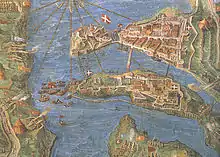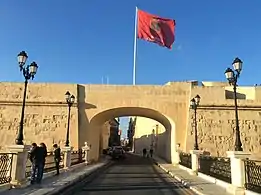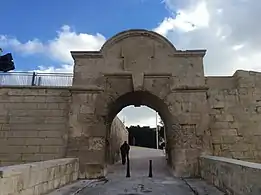Fortifications of Birgu
The fortifications of Birgu (Maltese: Is-Swar tal-Birgu) are a series of defensive walls and other fortifications which surround the city of Birgu, Malta. The first fortification to be built was Fort Saint Angelo in the Middle Ages, and the majority of the fortifications were built between the 16th and 18th centuries by the Order of Saint John. Most of the fortifications remain largely intact today.
| Fortifications of Birgu | |
|---|---|
Is-Swar tal-Birgu | |
| Birgu, Malta | |
 St. John Bastion and the Advanced Gate | |
 Map of Birgu's fortifications | |
 Birgu | |
| Coordinates | 35°53′10″N 14°31′22.8″E |
| Type | City wall |
| Site information | |
| Owner | Government of Malta |
| Condition | Mostly intact |
| Site history | |
| Built | c. 13th century–1691 (Fort St. Angelo) 1530s–18th century (rest of city walls) |
| Built by | Order of Saint John |
| Materials | Limestone |
| Battles/wars | Attack of 1551 Great Siege of Malta (1565) Siege of Malta (1798–1800) |
| Garrison information | |
| Past commanders | Jean de Valette (1565) |
Birgu's fortifications have been on Malta's tentative list of UNESCO World Heritage Sites since 1998, as part of the Knights' Fortifications around the Harbours of Malta.[1] They are also listed as monuments in Birgu as part the National Inventory of the Cultural Property of the Maltese Islands (NICPMI).
History
Hospitaller rule

The first fortification to be built in Birgu was the Castrum Maris. It is popularly attributed to have been built by the Arabs in around 870, but the earliest references to the castle date back to around the 13th century.[2]
In 1526, the Order of Saint John sent a commission of 8 knights to inspect the island of Malta, which had been offered to them by Emperor Charles V as a potential base following their loss of Rhodes. They described Birgu as a small defenceless town, with its only fortification being the obsolete and partially ruined Castrum Maris.[3]
The Order eventually moved to Malta in 1530 and established itself in Birgu. The first modifications were made to the Castrum Maris, which became Fort Saint Angelo and was used as the Grand Master's residence. Later on, the entire town began to be surrounded by walls, in a similar style to the Order's earlier defences in Rhodes. Birgu's land front was built by 1540.[4]
In 1551, Ottomans attempted to attack Birgu but turned back once they saw the new defences. They attacked again with a much larger force fourteen years later in 1565. The siege, which became known as the Great Siege of Malta, lasted for three months and Birgu was heavily bombarded. After the Great Siege, Birgu's fortifications were repaired, but soon lost most of their importance as the Order moved to its new capital Valletta, and built new fortifications there.
In the 17th and 18th centuries, the Santa Margherita Lines and the Cottonera Lines were built around Birgu's and Senglea's land fronts. These new lines increased the strength of the defensive position, but also reduced the importance of Birgu's land front. Birgu's fortifications were extensively rebuilt in the 18th century, under the direction of the architect Charles François de Mondion.
On 18 July 1806, the gunpowder magazine of Birgu exploded, killing over 200 people.[5]
The fortifications of Birgu were included on the Antiquities List of 1925.[6]
Present day
The first plans to restore the fortifications of Birgu were made in 2006, as part of a project that would also involve restoration of the fortifications of Valletta, Mdina and the Cittadella.[7][8] Restoration of Birgu's fortifications began in January 2008, and is currently ongoing.[9]
During the course of restoration work, a bastion that had been built just before the siege of 1565 as well as an 18th-century caponier were discovered.[10] A 20th-century naval oil depot near the Post of Castile was demolished in 2010 to reveal the view of the bastions,[11] and a breach in St. John Bastion was bridged by an arch the following year.[12]
Birgu's ditch was opened to the public as a recreational area in January 2016. The recreational area includes the 18th-century caponier, which was restored and partially reconstructed, as well as the battery at the left extremity of the ditch.[13]
Layout

The present layout of Birgu's fortifications is mainly a result of the 18th century rebuilding by the French architect Charles François de Mondion, although the general layout dates back to the mid-16th century. The fortifications consist of (listed going clockwise from Fort St. Angelo to Dockyard Creek):
- Fort Saint Angelo – a large bastioned fort, originally a castle built in or before the 13th century, modernized between the 16th and 17th centuries by the Order of Saint John. The present layout dates back to a major reconstruction by Flemish architect Carlos de Grunenbergh in the 1690s. For more details about the fort's layout, see here.
- An irregular enceinte, beginning from the moat of Fort St. Angelo and ending at the Post of Castile. Its northern end was occupied by a battery, now partially dismantled.[14]

- Post of Castile (Maltese: Il-Prexxa, Italian: La Breccia) – the east extremity of the Birgu Land Front. It was originally built before 1565 and played a crucial role in the Great Siege. The present layout dates back to the 18th century, and consists of a retrenchment and a hornwork.[15]
- St. James Bastion – a two-tiered pentagonal bastion built prior to 1565 and redesigned by de Mondion in the 18th century.[16] Part of the original 16th century bastion was rediscovered during restoration works.[10]
- French Curtain – a curtain wall linking St. James and St. John Bastions.[18]
- St. John Bastion – a large asymmetrical bastion containing two of the three main gates of Birgu, designed by de Mondion in the 18th century. A modern road passes through an arch in the bastion.[12][19]

- Couvre Porte Counterguard – a pentagonal counterguard built to protect St. John Bastion. It was built during the reign of Antoine de Paule, and was modified in the 18th and 19th centuries. The British developed its casemates into a barracks,[21] which now houses the Malta at War Museum.[22]
- A curtain wall linking St. John Bastion to Dockyard Creek. Originally there was a small bastion but this was destroyed in the explosion of 1806.[23]
The entire land front is surrounded by a rock-hewn ditch, which also includes a caponier[24] and another battery.[25] A covertway and glacis were also located close to the land front, but were mostly cleared away in the 19th century.[26]
Birgu had four city gates, three of which still survive. They were designed by Charles François de Mondion in the 18th century, and are in the Baroque style:[27]
- Couvre Porte Gate – the first of the three main gates, located within the west side of Couvre Porte Counterguard.[28]
- Advanced Gate – the second of the three main gates, located on the right face of St. John Bastion.[29]
- Gate of Provence – the third and last of the three main gates, located on the inner flank of St. John Bastion.[30]
- Porta Marina – a gate located on the western extremity of Birgu. It was destroyed in the explosion of 1806.
 Couvre Porte Gate
Couvre Porte Gate Advanced Gate
Advanced Gate Gate of Provence
Gate of Provence Modern arched opening in St. John Bastion
Modern arched opening in St. John Bastion Outer gate originally leading to the now-demolished Porta Marina
Outer gate originally leading to the now-demolished Porta Marina
References
- "Knights' Fortifications around the Harbours of Malta". UNESCO Tentative List. Retrieved 12 June 2015.
- Spiteri, Stephen C. (26 July 2010). "Fort St Angelo during the Great Siege". MilitaryArchitecture.com. Archived from the original on 11 January 2017. Retrieved 12 June 2015.
- Zahra, Lorenzo A. (10 January 2007). "The Auberges of France in Birgu". The Malta Independent. Retrieved 10 June 2015.
- "Birgu's Fortifications". Birgu Local Council. Retrieved 10 June 2015.
- "Explosion Polverista Vittoriosa". Medical Officers of the Malta Garrison. Archived from the original on 22 February 2017.
- "Protection of Antiquities Regulations 21st November, 1932 Government Notice 402 of 1932, as Amended by Government Notices 127 of 1935 and 338 of 1939". Malta Environment and Planning Authority. Archived from the original on 19 April 2016.
- Zammit, Ninu (12 December 2006). "Restoration of forts and fortifications". Times of Malta. Retrieved 10 June 2015.
- "A fortune on fortifications". Times of Malta. 20 June 2008. Retrieved 10 June 2015.
- "Restoration of the Birgu Fortifications - ERDF Project". Birgu Local Council. Retrieved 10 June 2015.
- "Pre-Great Siege bastion unearthed". Times of Malta. 5 October 2012. Retrieved 12 June 2015.
- "Bastions revealed as Vittoriosa's old oil depot is demolished". Times of Malta. 25 June 2010. Retrieved 12 June 2015.
- "Arch bridges gap in bastions". Times of Malta. 13 April 2011. Retrieved 12 June 2015.
- "Il-foss tal-Birgu jingħata ħajja ġdida b'investiment ta' miljun ewro". TVM (in Maltese). 27 January 2016. Archived from the original on 27 January 2016.
- "Enceinte along Kalkara side - Birgu" (PDF). National Inventory of the Cultural Property of the Maltese Islands. 28 June 2013. Retrieved 13 July 2015.
- "Post of Castile - Birgu" (PDF). National Inventory of the Cultural Property of the Maltese Islands. 28 June 2013. Retrieved 13 July 2015.
- "St James Bastion - Birgu" (PDF). National Inventory of the Cultural Property of the Maltese Islands. 28 June 2013. Retrieved 13 July 2015.
- "St James Cavalier - Birgu" (PDF). National Inventory of the Cultural Property of the Maltese Islands. 28 June 2013. Retrieved 13 July 2015.
- "French Curtain - Birgu" (PDF). National Inventory of the Cultural Property of the Maltese Islands. 28 June 2013. Retrieved 13 July 2015.
- "St John Bastion - Birgu" (PDF). National Inventory of the Cultural Property of the Maltese Islands. 28 June 2013. Retrieved 13 July 2015.
- "St John Cavalier - Birgu" (PDF). National Inventory of the Cultural Property of the Maltese Islands. 28 June 2013. Retrieved 13 July 2015.
- "Couvre Porte Counterguard - Birgu" (PDF). National Inventory of the Cultural Property of the Maltese Islands. 28 June 2013. Retrieved 13 July 2015.
- "Visitor Information". Malta at War Museum. Retrieved 12 June 2015.
- "Short stretch of stepped curtain wall leading down to Birgu Creek - Birgu" (PDF). National Inventory of the Cultural Property of the Maltese Islands. 28 June 2013. Retrieved 13 July 2015.
- "Remains of Caponier - Birgu" (PDF). National Inventory of the Cultural Property of the Maltese Islands. 28 June 2013. Retrieved 13 July 2015.
- "Battery of Ditch - Birgu" (PDF). National Inventory of the Cultural Property of the Maltese Islands. 28 June 2013. Retrieved 13 July 2015.
- "Covertway - Birgu" (PDF). National Inventory of the Cultural Property of the Maltese Islands. 28 June 2013. Retrieved 13 July 2015.
- "The Couvre Porte". malta.com. Retrieved 12 June 2015.
- "Couvre Porte Gate - Birgu" (PDF). National Inventory of the Cultural Property of the Maltese Islands. 28 June 2013. Retrieved 13 July 2015.
- "Advanced Gate - Birgu" (PDF). National Inventory of the Cultural Property of the Maltese Islands. 28 June 2013. Retrieved 13 July 2015.
- "Main Gate - Birgu" (PDF). National Inventory of the Cultural Property of the Maltese Islands. 28 June 2013. Retrieved 13 July 2015.
External links
| Wikimedia Commons has media related to Military buildings in Birgu. |